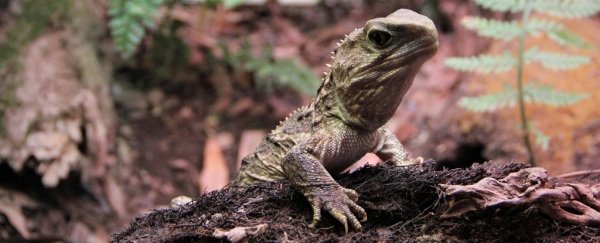In the evolutionary tree of life, the lizard-like tuatara from New Zealand is on a branch all to itself.
In the time of the dinosaurs, this extraordinary animal had lots of relatives all around the world, and yet now, there's nothing else like it on Earth.
According to new sequencing of the tuatara's entire genome - one of the largest on record and 50 percent larger than the human genome - it appears this strange creature is neither lizard, bird, nor mammal. Rather, it's some strange amalgamation of all three.
According to the authors of the new study, the animal's genomic architecture is unlike anything previously reported.
"The tuatara genome contained about 4 percent jumping genes that are common in reptiles, about 10 percent common in monotremes (platypus and echidna) and less than 1 percent common in placental mammals such as humans," says biologist David Adelson from the University of Adelaide, Australia.
"This was a highly unusual observation and indicated that the tuatara genome is an odd combination of both mammalian and reptilian [including bird] components."
Scientists already knew the tuatara (Sphenodon punctatus) was something else, but this new research suggests it's even more unique than we suspected.
Found solely in New Zealand, the tuatara - which does greatly resemble a lizard to the untrained eye - is considered a taonga, or 'special treasure' for the local Māori. And for good reason.
These nocturnal creatures can live for a century, withstand super cold temperatures, hold their breath for as long as an hour, and see light out of a third 'parietal eye' on their heads.
Today, the species' closest relatives are snakes and lizards, but to call them relatives is a bit like calling a kangaroo a relative of humans. Their common ancestor actually goes back some 250 million years.
Throughout that huge amount of time, tuatara have remained the sole members of the archaic reptilian order known as Rhynchocephalia.
"This species represents an important link to the now-extinct stem reptiles from which dinosaurs, modern reptiles, birds and mammals evolved, and is thus important for our understanding of amniote evolution," the research team writes in their paper.
The tuatara retains features of the ancient and long-extinct animals from which all these groups evolved from. The researchers that sequenced its genome note this species is the slowest-evolving reptile yet analysed, more so than any other lizard or snake.
As such, tuatara are a direct line back to our origins, but their continued existence on our planet is not a sure bet.
While their numbers are doing okay now, as tuatara are protected on all 35 islands they are found on in New Zealand, a rapidly changing climate could spell their eventual doom.
The sex of future tuatara depends heavily on the temperature surrounding the eggs, and global warming could lead to too many males being born, sending the reproductive cycle into an imbalance.
The authors of the new study say tuatara "remain imperilled owing to their highly restricted distribution, threats imposed by disease and changes in sex ratios induced by climate change that could markedly affect their survival."
Knowing more about the species is crucial for its continued survival. But this genomics research is important for other reasons, too.
The research was done in partnership with the Ngātiwai, the Māori iwi (tribe) who hold kaitiakitanga (guardianship) over the tuatara populations; this sort of collaboration is not always considered in conservation research.
"This partnership - which, to our knowledge, is unique among the genome projects undertaken to date - had a strong practical focus on developing resources and information that will improve our understanding of the tuatara and aid in future conservation efforts," the authors write.
"It is hoped that this work will form an exemplar for future genome initiatives that aspire to meet access and benefit-sharing obligations to Indigenous communities."
Sharing knowledge is important, as is sharing credit. The Ngātiwai Trust Board is listed amongst the authors of the paper.
The study was published in Nature.
